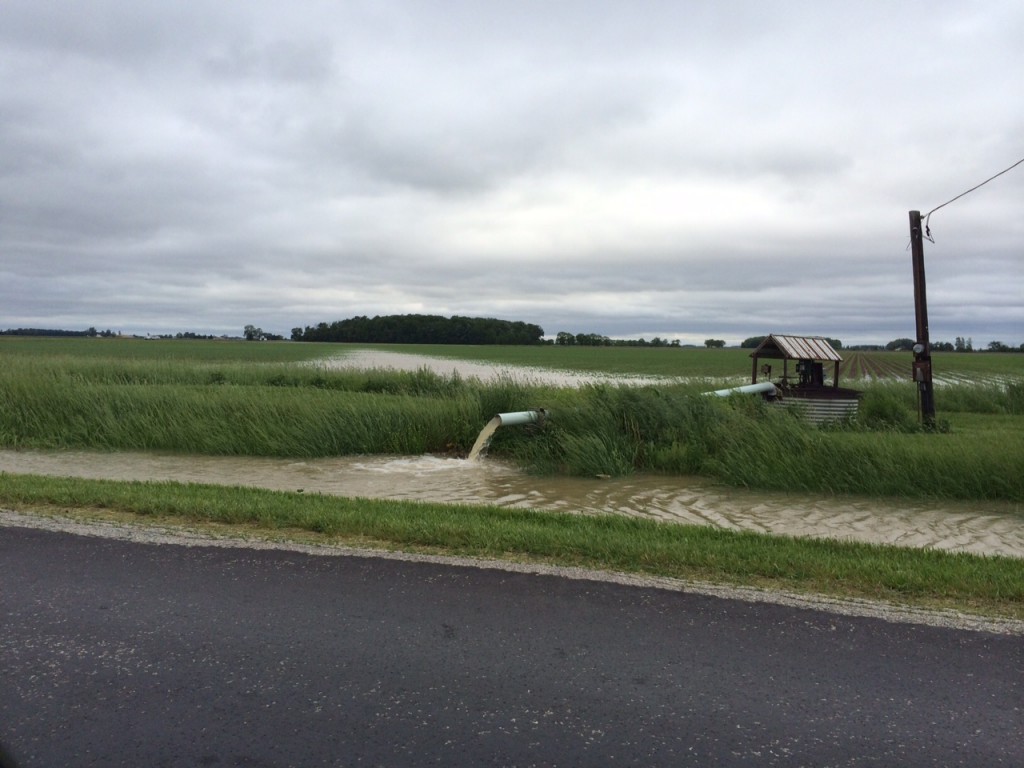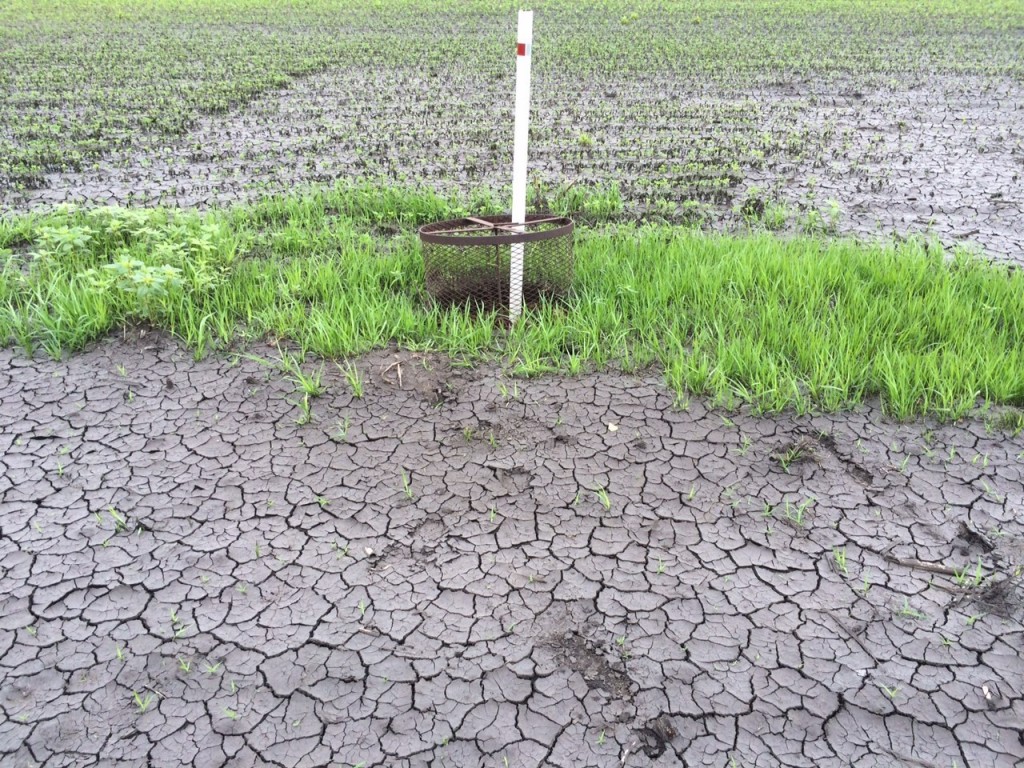16 November 2015
Field Drain Tile and the “Re-Eutrophication” of Lake Erie
Posted by John Freeland

Field water is pumped from a drain tile pump station into a roadside ditch en route to the River Raisin and western Lake Erie. Lenawee County, Michigan (June 2015).
Algae Blooms, Microcystin and Phosphorus
It’s been over a year since Toledo, Ohio and surrounding communities shut down public water supplies due to an algae bloom and microcystin contamination in western Lake Erie. Was the trouble a “one-off” or can we expect more of these events in the future?
While attending a seminar this year hosted by the Michigan Chapter of the Soil and Water Conservation Society, my interest was piqued when one of the presenters, Dr. David Baker, used the term “re-eutrophication” to describe what’s going on in Lake Erie. Eutrophication is an ecological process in waterbodies whereby phosphorus loading leads to dense algae blooms, the algae die and decay, using up oxygen from the water column. Oxygen deprivation then stresses fish and other organisms. Baker has been studying nutrient loading in Lake Erie for decades and compiling an impressive data set including total and dissolved reactive phosphorus entering major tributaries to the Lake. The data points to intensive row-crop agriculture as a major source of the phosphorus that can cause eutrophication.
Baker’s presentation (powerpoint) described total (TP), particulate phosphorus (PP) and dissolved reactive phosphorus (DRP) like this”
TP = PP + DRP
For algae, only about 25% of the PP is available and useful, while 100% of the DRP is available.
Understanding this compartmentalization of phosphorus and the sources of each type is important to understanding and managing the problem of eutrophication.
Eutrophication and Re-Eutrophication
In the 1960’s nutrient inputs from untreated sewage, agricultural runoff and other industrial chemical created such a mess in Lake Erie that the government finally did something about it. In 1972, the Clean Water Act was passed along with a cooperative agreement between the United Sates and Canada called the Great Lakes Water Quality Agreement. Both of these initiatives led to target load levels, regulations and enforcement efforts that significantly reduced phosphorus and other pollutants from the discharge of point-source industrial and municipal wastes.
Total phosphorus levels declined before leveling off at below target levels in 1981. Water quality in Lake Erie improved for about 15-years. However, in recent years, we have witnessed worsening algal blooms in Lake Erie. Why? The answer appears to be increased levels of DRP. Although it’s a small fraction of the TP, the DRP is 100% available to algae and therefore fuels their growth.
David Baker’s presentation suggested several reasons for an increase in DRP loading, including more broadcast fertilizer, using more fertilizer, concentration of phosphorus fertilizer near the soil surface under no-till management, and more drain tile.
Subsurface Drainage and Runoff
From what I see on farms near where I live, farmers are installing a lot of new drain tile (video). The video describes what the process looks like and why farmers like to use it.
Contrary to the soil-water filtering claims made in the video linked above, other researchers have found significant quantities of phosphorus discharged from drainage tiles. Soil does not always filter very well due to preferential flow through macropores as described here, and here and here.
Most soil conservation practices that also benefit water quality slow water down as it moves across the landscape. Filter strips, grassed waterways and vegetated buffers are ways to reduce surface flow and reduce soil and nutrient losses. After all, the farmer has no interest in losing fertilizer down the river. The problem comes when there is too much water and the field needs to be drained for equipment access and growth of healthy crops. Drainage tile essentially insures the farmer from crop damage in wet years. There is also some evidence that the earlier a farmer can work land in the spring, the better the final yield. For now, farmers near Lake Erie have incentives to install more subsurface drainage.




 John Freeland earned a PhD in Soil Science (Pedology) at North Dakota State University and is a consultant working in the private sector. He has published soils research and taught at the high school and college levels. John is interested in wetlands, soil genesis, science communication, the intersection of art and science, and soil-water-landscape processes. John lives near the Ohio-Michigan border and plays bass in multiple music projects.
John Freeland earned a PhD in Soil Science (Pedology) at North Dakota State University and is a consultant working in the private sector. He has published soils research and taught at the high school and college levels. John is interested in wetlands, soil genesis, science communication, the intersection of art and science, and soil-water-landscape processes. John lives near the Ohio-Michigan border and plays bass in multiple music projects.
My friend bought a farm last year and has been wondering what might help his farm succeed. Thank you for explaining that drainage tile helps farmers during wet years or wet seasons. If that’s the case, when is the best time to get them installed? https://plumbingandelectricservice.com/services